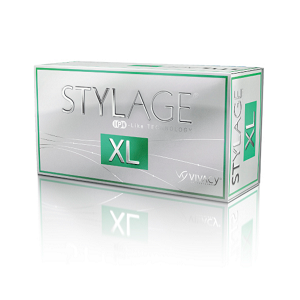Stylage XL 2x1ml
Stylage XL 2x1ml
FILLING AND SMOOTHING DEEP LINES AND WRINKLES
This most dense gel based on hyaluronic acid from the Stilage series effectively fights wrinkles in the deep layers of the dermis. Helps to eliminate the lack of volume in the area of the temples, cheekbones, cheeks and giants. Contains mannitol – an antioxidant, which prolongs the effect of the drug to 12-18 months. Packing: 2 syringes x 1.0 ml
Stylage XL 2x1ml is the first monophasic antioxidant cross-linked hyaluronic acid based gel sterile, completely biogradable, of non-animal origin, specifically designed for the natural correction of deep to very deep wrinkels.
The presence of mannitol, the “free radical scavenger”, limits the devastating effects of free radicals on the dermis and product injected, thus reducing the risk of post-injection inflammation and preventing the gel’s structure degradation.
Contour plastic with hyaluronic fillers has become a real salvation for those customers who are concerned about severe skin deformities and soft tissue deficit, formed due to age, disease or natural pathology. To help such people come fillers of the greatest density, which fill the missing volume of tissue, increasing the tension of the skin on the face, which leads to smoothing of deep wrinkles.
One such drug is a gel based on stabilized hyaluronic acid with a concentration of 26 mg / g – Stylage XL. This drug was developed by the French corporation Laboratoire Vivacy and released on the world market in 2006. This gel is the densest of the entire Stilage line.
COMPOSITION:
Cross-linked hyaluronic acid IPN-Like + mannitol
CONCENTRATION:
26 mg/g
PACKAGING:
Each box contains two 1 ml pre-filled glass, latex free syringes of STYLAGE XL gel, sterilized by moist heat autoclaving, and 4 sterile single use needles, two 27G½ and two
REMANANCE:
-12 months
The duration of the effect of a STYLAGE XL treatment is very individual and depends on many factors, such as the patient’s skin type and structure, age, lifestyle, the area treated and the injection technique used by the practitioner.

